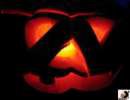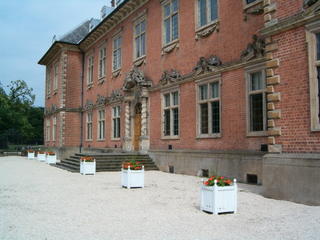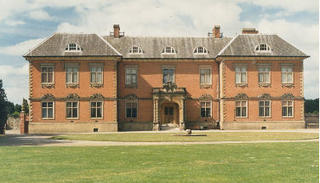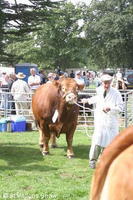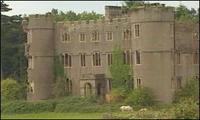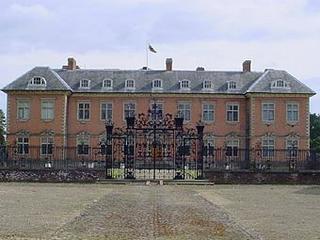 "It is here that nobility resides, where there is feasting and where comforts are nurtured: a fair lordship and dukedom has been established near Basaleg."
"It is here that nobility resides, where there is feasting and where comforts are nurtured: a fair lordship and dukedom has been established near Basaleg." So wrote
Dafydd ap Gwilym, of Ifor Hael's Llys (or 'court') at Gwern y Cleppa in the 14th century.
Ifor ap Llewelyn, second son of Llewelyn ap Ifor and Angharad of Tredegar, was assured by his bard that "As long as the Welsh language continues your praise will be sung." As the Eistedfodd returned to the grounds of Tredegar House last year, it was readily apparent that Dafydd was as good as his word. The name of
Ifor Hael (Ifor the Generous, as Dafydd termed him) has indeed lived on.
Dafydd ap Gwilym, like Ifor, had roots in Dyfed. There has been speculation that political problems involving his family forced the bard to move to Gwent. Some have called Dafydd the greatest of all Welsh poets, and certainly the most renowned bard of medieval Wales. It was at Gwern y Cleppa, at the court of Ifor Hael, that he enjoyed the munificent hospitality that inspired some of his greatest work. It was to prove an excellent partnership. Ifor could not have wished for a better man to sing his praises, and ultimately, to immortalise him.
The atmosphere at Gwern y Cleppa in those days can be imagined. It was described as a centre of civilised living, as being the very symbol of gentility, grace and luxury, where the spirit of chivalry mixed with the old Welsh traditions. As head of the Llys, Ifor Hael, Dafydd tells us, was the embodiment of courage, wisdom, generosity and justice. He was compared to Rhydderch Hael, one of the three generous men of the Isle of Britain. The bard certainly enjoyed his stays:
"drinking with Ifor, and shooting straight-running great stags. And casting hawks to the sky and wind, and beautiful verses, and solace in Bassaleg."Sadly for our so far idyllic story, it was not just the free-flowing drink with Ifor, and the great stags near Gwern y Cleppa, that appealed to Dafydd; he was appointed to act as tutor to Ifor's daughter and, rather inconveniently, fell in love with her. It can be imagined how the music and gaiety suddenly stopped at Llys Ifor Hael when the great man discovered this. Greatly disapproving of such a match, Ifor sent his daughter to Anglesey, away from the romantic attentions of the silken tongued bard. Dafydd promptly followed to Angelsey, but was ultimately frustrated, not least by the fact that Ifor's daughter took the veil and became a nun. The breach with his patron was not critical however, and Dafydd returned to Gwent, and continued showering praise on Ifor. ( In later years Dafydd again fell in love controversially, and Ifor welcomed the couple to Gwern y Cleppa)
The Morgans of Tredegar were well aware of the importance of their illustrious forbear, and for many years, an avenue of trees led from Tredegar House to the old Llys at Gwern y Cleppa, which became, not so much a physical court, but more a spiritual one for the Morgans. Ifor Hael became not just a man, but an ideal to aspire to. His name was evoked many times in the history of the Morgans: Sir John ap Morgan made the halls of Tredegar ring with song with his employment of Welsh bards, as did the Elizabethan adventurer Miles Morgan; we can see strains of Ifor's princely hospitality in the socialising of Sir William Morgan in the early 18th century, and the lavish praise Ifor received found a mirror in the praise poured on Sir Charles Morgan in the 19th century ("One of the Kings of south Wales"). Ifor's name was frequently used by the Morgans in political campaigns. Who would dare to oppose a descendant of Ifor Hael in south Wales? Had the electors not read their Dafydd ap Gwilym?
Perhaps the closest the Morgans ever reached to the heady adulation and reputation enjoyed by Ifor came in the late Victorian era, when the war hero and generous public benefactor Godfrey Morgan, 1st Viscount Tredegar, was acclaimed in the area as, what else?, 'Ifor Hael the Second'.
Although Ifor's reputation remained untarnished, the old court of Gwern y Cleppa did not. The 18th century bard Evan Evans (1731-1788) who went by the name Ieuan Brydydd Hir visited it, and wrote:
"Ifor Hael's court, wretched sight, lies destroyedJust heaps of stones in the treesWhere the thorns and brambles growIn the place where majesty flourished"There is very little to see now at Gwern y Cleppa, the site itself has not been built on, but, in the words of Ieuan:
"The ancient paths where there was once song are now the haunts of owls."
 It is the prerogative of every 'Lord Tredegar' at Christmas at Tredegar House to choose the name of his butler. As butler this year I was in charge of chocolates (a grave responsibility) and of introducing visitors to Lord and Lady Tredegar in the Dining Room. For the first couple of nights Lord Tredegar was played by Alan Hall (tour guide of some distinction), who decided that in keeping with the Dickensian spirit pervading the House, that I was to be called 'Tulkinghorn'. Sadly, and probably because of the immense stress placed on members of the aristocracy at this time of year, the endless handshaking proved to be too much for His Lordship's constitution, and he was forced to retire from the post. Tenants on the estate wept, but, as ever, life at Tredegar had to continue.
It is the prerogative of every 'Lord Tredegar' at Christmas at Tredegar House to choose the name of his butler. As butler this year I was in charge of chocolates (a grave responsibility) and of introducing visitors to Lord and Lady Tredegar in the Dining Room. For the first couple of nights Lord Tredegar was played by Alan Hall (tour guide of some distinction), who decided that in keeping with the Dickensian spirit pervading the House, that I was to be called 'Tulkinghorn'. Sadly, and probably because of the immense stress placed on members of the aristocracy at this time of year, the endless handshaking proved to be too much for His Lordship's constitution, and he was forced to retire from the post. Tenants on the estate wept, but, as ever, life at Tredegar had to continue. Life continued, and Lady Tredegar acquired her second husband within a week, when Michael stepped into the role. Here we see him looking distracted; he can hardly be blamed, with Fagin and the Artful Dodger given free reign of his ancestral home, it was a trying time for His Lordship. How many spoons bearing the Morgan family crest made it into the pockets of these Victorian ne'er do wells, only the House Steward, after much consultation with the Housekeeper, could be sure.
Life continued, and Lady Tredegar acquired her second husband within a week, when Michael stepped into the role. Here we see him looking distracted; he can hardly be blamed, with Fagin and the Artful Dodger given free reign of his ancestral home, it was a trying time for His Lordship. How many spoons bearing the Morgan family crest made it into the pockets of these Victorian ne'er do wells, only the House Steward, after much consultation with the Housekeeper, could be sure.


